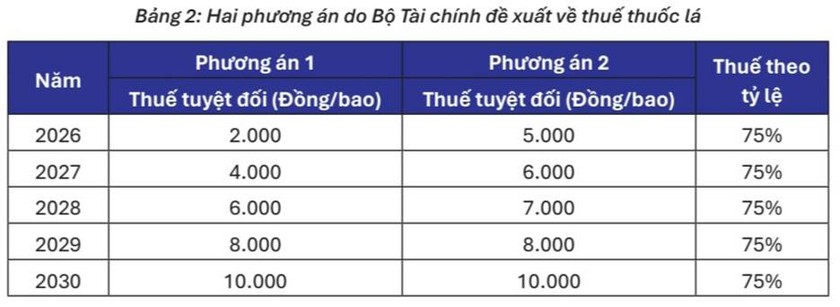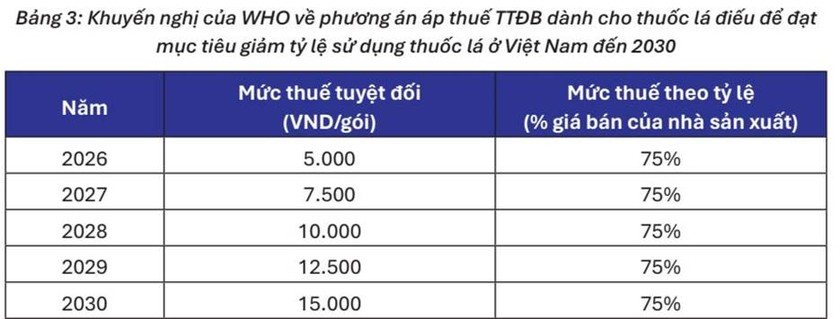According to the WHO report in 2021, tobacco use has been causing a burden of disease and premature death in Vietnam, with more than 100,000 tobacco-related deaths each year. Of these, 84,500 people die/year due to active smoking and 18,800 people die due to passive exposure to tobacco smoke.
In addition, the medical costs and economic losses due to tobacco use are huge (VND 108,000 billion, equivalent to 1.14% of GDP in 2022). The use of tobacco products has a negative impact on economic and social development, making it difficult to achieve Vietnam's national health goals, as well as the commitment to achieve the Sustainable Development Goals (SDGs) related to health.
To continue reducing the burden of disease and death caused by tobacco use, in 2023, the Prime Minister approved the National Strategy on Tobacco Harm Prevention and Control to 2030, according to which one of the important goals is to reduce the smoking rate among men (aged 15 and over) to below 36% by 2030.
According to the Tobacco Harm Prevention Fund (Ministry of Health), increasing tobacco tax has been proven to be the most effective and least expensive measure to reduce tobacco use, especially to prevent youth from smoking. This measure not only helps protect public health, reduce the burden of disease and death, but also increases revenue from tobacco tax for the budget, helping to promote the achievement of our country's sustainable development goals. Therefore, increasing tobacco tax is considered a win-win measure: it protects health, increases government revenue and helps development.
Ministry of Finance proposes 2 options to increase special consumption tax on tobacco
Option 1 maintains the tax rate of 75% and adds an absolute special consumption tax (SCT) on tobacco products. Specifically, from 2026, each pack of cigarettes will be subject to an additional SCT of VND 2,000 and this tax will increase gradually each year, reaching VND 10,000 in 2030. Thus, the SCT revenue on tobacco will increase from VND 17.6 trillion in 2022 to VND 23.7 trillion in 2026 and VND 39.1 trillion in 2030.
Option 2 also maintains the tax rate of 75%, but from 2026, an absolute special consumption tax of VND5,000/pack will be applied. Each year thereafter, it will increase by VND1,000/pack, reaching VND10,000/pack by 2030. Special consumption tax revenue on cigarettes will increase from VND17.6 trillion in 2022 to VND30 trillion in 2026 and VND39.2 trillion in 2030.
The Tobacco Harm Prevention Fund believes that both of the above options of the Ministry of Finance can help reduce the rate of adult smokers by about 9% in 2030 compared to 2020. However, option 2 will lead to an earlier reduction in the smoking rate due to a higher starting increase from 2026, thereby bringing greater benefits in disease prevention and reducing health care costs.
However, both options are still far from achieving the target of reducing smoking rates according to the National Strategy on Tobacco Harm Prevention and Control by 2030. These two options are forecast to reduce the smoking rate among men in Vietnam to 37.5% by 2030, but still fall short of the target of the National Strategy on Tobacco Harm Prevention and Control (below 36%) and are also far from the target of the Vietnam Health Program and the SDGs, which is to reduce the smoking rate among men to below 32% by 2030.
Thus, although both options have the positive point of including a mixed tax system with periodic increases to reduce tobacco affordability, the tax increases are still not strong enough to achieve the proposed health goals.
WHO and Ministry of Health proposed plan
According to WHO recommendations, to achieve the goals of the National Strategy on Tobacco Harm Prevention and Control by 2030, Vietnam needs to apply a stronger tax increase plan than the plans of the Ministry of Finance. Specifically, WHO and the Ministry of Health propose to apply an absolute tax according to the roadmap to reach 15,000 VND/pack by 2030 and maintain the current tax rate of 75%.
This option will help reduce the smoking rate among adults. Reduce the number of smokers by 3.2 million by 2030 compared to the scenario of no tax increase. This reduction is higher than the current plan of the Ministry of Finance of one million smokers. Increase real tax revenue (adjusted for inflation) by 169%, from 17.4 trillion VND in 2020 to 46.4 trillion VND in 2030 (an increase of 29 trillion VND). This increase is higher than the increase according to the plan of the Ministry of Finance of nearly 10 trillion VND.
"When compared with the Ministry of Finance's option 2, the strong tax reform option proposed by WHO and the Ministry of Health can bring about a more significant reduction in smoking rates, helping to achieve the national goal of tobacco control," the Tobacco Harm Prevention Fund informed.
Minh Trang
Source: https://baophapluat.vn/kich-ban-nao-vua-giup-dat-muc-tieu-quoc-gia-ve-kiem-soat-thuoc-la-vua-tang-thu-ngan-sach-post547615.html






![[Photo] Prime Minister Pham Minh Chinh works with the Standing Committee of Thai Binh Provincial Party Committee](https://vphoto.vietnam.vn/thumb/1200x675/vietnam/resource/IMAGE/2025/5/12/f514ab990c544e05a446f77bba59c7d1)
![[Photo] Prime Minister Pham Minh Chinh starts construction of vital highway through Thai Binh and Nam Dinh](https://vphoto.vietnam.vn/thumb/1200x675/vietnam/resource/IMAGE/2025/5/12/52d98584ccea4c8dbf7c7f7484433af5)
![[Photo] Prime Minister Pham Minh Chinh receives Swedish Minister of International Development Cooperation and Foreign Trade](https://vphoto.vietnam.vn/thumb/1200x675/vietnam/resource/IMAGE/2025/5/12/ae50d0bb57584fd1bbe1cd77d9ad6d97)





















































































Comment (0)